On Matchday three of this season’s new-look UEFA Champions League, the Santiago Bernabéu hosted a tantalising rematch of last year’s finale, with Real Madrid taking on Borussia Dortmund.
For a team so formidable on the European stage, Carlo Ancelotti’s superstars have emerged out of the blocks with relative caution, having struggled to break down Stuttgart and receiving a surprise loss at the hands of Lille.
This week’s German opposition have had the complete opposite start to their Champions League campaign, with new head coach Nuri Şahin guiding BVB to consecutive victories, including a 7-1 demolition of Celtic.
Heading into the match, there was a resounding acceptance that either side must collect all three points, especially considering the respite that a top-eight finish would provide in an already hectic club calendar.
Real Madrid would eventually secure a 5-2 victory thanks to some impactful tactical tweaks and moments of individual brilliance from the soon-to-be Ballon d’Or winner, Vinicius Junior, but it was undoubtedly a game of two drastically different halves where Los Blancos are concerned.
Borussia Dortmund played with freedom and comfort in the opening stages, which allowed them to demonstrate their technical prowess when racing to a swift two-goal advantage.
The inevitable nature of Real Madrid in the Champions League came to fruition once again, but it certainly has sparked analysis and discussion surrounding the effectiveness of Ancelotti’s tactics this season.
Our tactical analysis will begin to delve into the most interesting aspects of the Real Madrid vs Dortmund tie, highlighting where it all went wrong for Dortmund after such a bright start and, most importantly, how Madrid found a way to spark another comeback.
Real Madrid Vs Borussia Dortmund Starting Lineups
Real Madrid started their first UCL match since the loss of Dani Carvajal to a season-ending knee injury, allowing Lucas Vázquez to join a back four of Antonio Rüdiger, Éder Militão and Ferland Mendy, who could protect Thibaut Courtois between the sticks.
Ancelotti deployed a midfield line of Luka Modrić, Federico Valverde and Jude Bellingham, playing behind the world-class attacking trio of Rodrygo Goes, Vinicius Junior and Kylian Mbappé.
On the other side of the field, Nuri Şahin’s formation opted for a 4-2-3-1 setup from the outset, with Gregor Kobel playing in the Dortmund goal behind a defensive line of Ramy Bensebaini, Nico Schlotterbeck, Niklas Süle and Julian Ryerson.
Felix Nmecha and Marcel Sabitzer comprised a multifaceted double pivot, allowing Julian Brandt to occupy space behind central striker Serhou Guirassy.
Donyell Malen and Jamie Gittens offered important width in the attack.
Madrid’s Messy Midfield
A recurring theme of Real Madrid’s season under Carlo Ancelotti’s coaching style this year has been their lack of that dominating presence within the midfield line.
We mentioned previously how the loss of Toni Kroos this summer has had detrimental effects on the fluidity and efficiency of their build-up play, but from the outset, we could see how Ancelotti’s starters were lacking in the defensive elements of the game.
Even though you may be forgiven for not settling into a proper defensive structure within the opening seconds of the match, we see how Real Madrid’s 4-4-2 pressing structure can be picked apart to put pressure on their defensive line immediately.
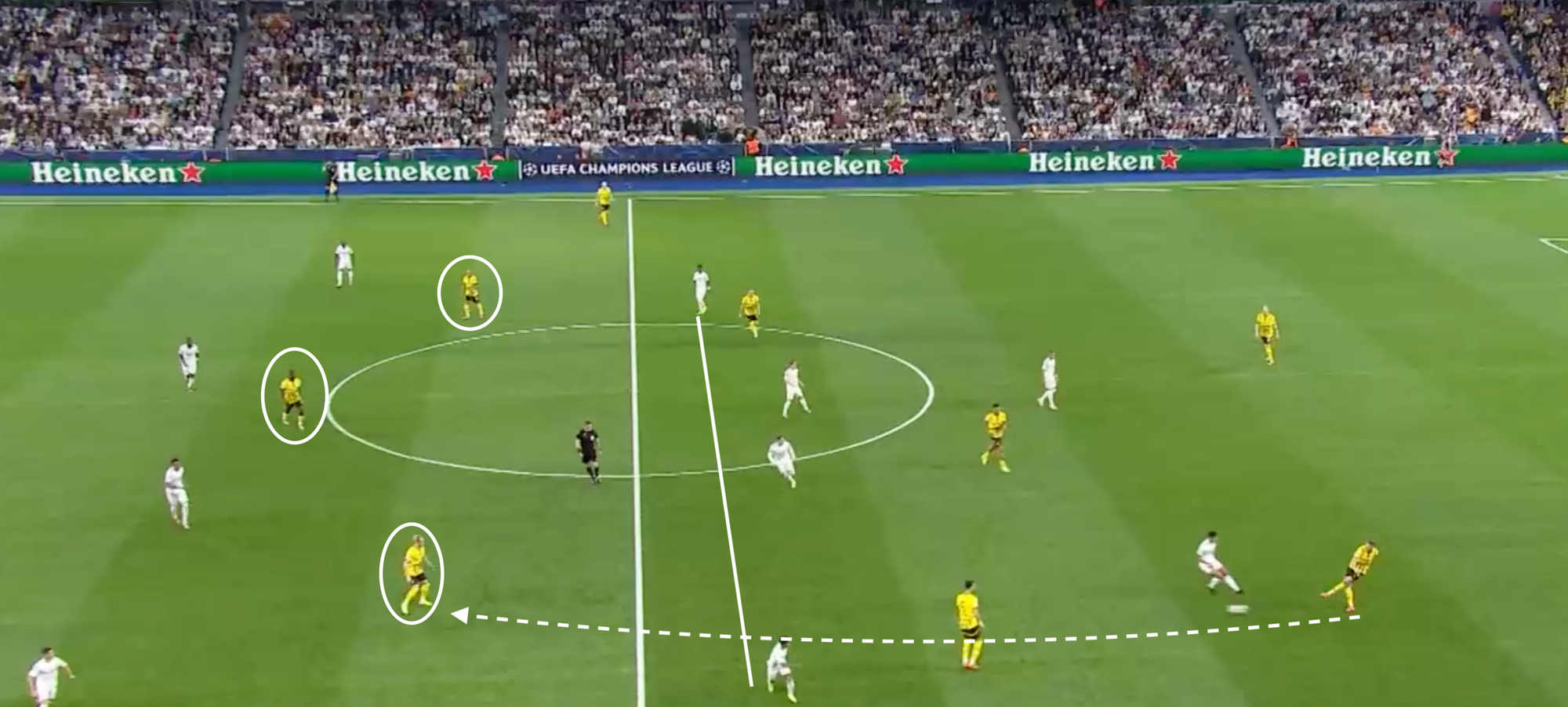
With Bellingham pressing high alongside Mbappé, this left just Modrić and Valverde to defend the interior of the pitch, two midfielders who are much more effective in possession and lack the defensive instincts to operate as a true holding midfielder.
The lack of defensive pressure and huge gaps between the defence and midfield allowed Dortmund’s three most influential offensive minds enough freedom to pick up possession and threaten early on.
One of the Bundesliga’s most progressive central defenders, Nico Schlotterbeck, jumped at the opportunity to produce line-breaking passes.
Despite our initial example occurring within the first minute, unfortunately, this trend continued for the home side, playing a massive role in the visitors’ opening goal.
This time, operating in a much deeper position towards their own goal, we see how the lack of defensive intuition from both Valverde and Modrić allowed Malen to pick up dangerous pockets of space and receive the ball into feet in and around the Madrid penalty area.
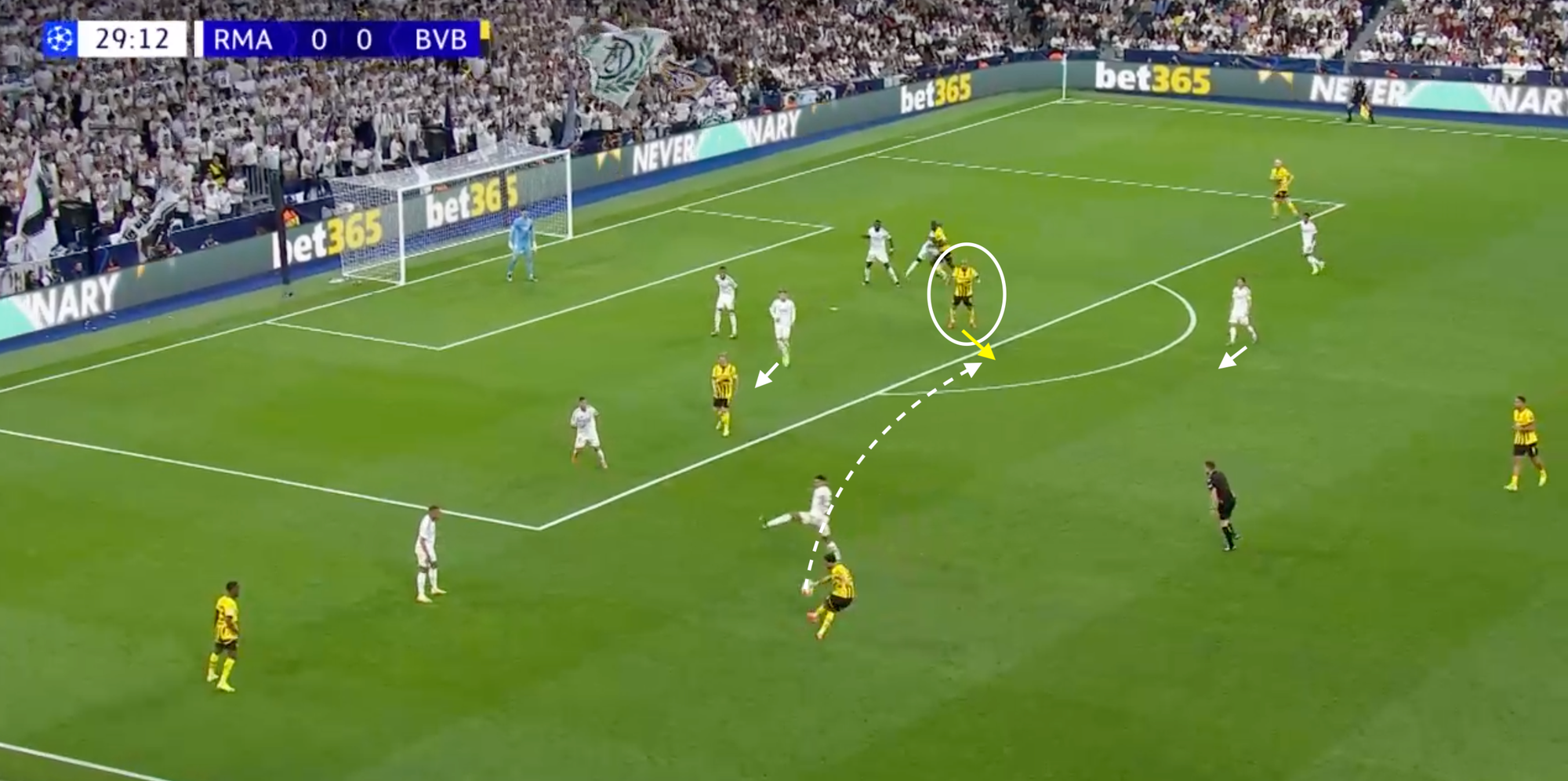
Crucially for Madrid, both central defenders remained fixated on their positioning, protecting the aerial threat within the penalty area.
This allowed the Dutch winger to roam unmarked and combine with Guirassy to slot the ball past Courtois, resulting in a 1-0 score.
Dortmund’s Impressive Movement
Such occurrences can also be attributed to Dortmund’s forwards’ excellent attacking movement and not just Madrid’s defensive frailties, which have been evident for what seems like most of the 2024/25 season.
This was evident in Dortmund’s second goal, as Serhou Guirassy‘s movement perfectly epitomised elite centre-forward play and confused two of the world’s best central defenders.
As the play progressed on the right flank, Guirassy initially appeared as though he would make a traditional dart into the penalty area, splitting both Militão and Rüdiger.
The Brazilian defender continually scanned the Guinean forward.
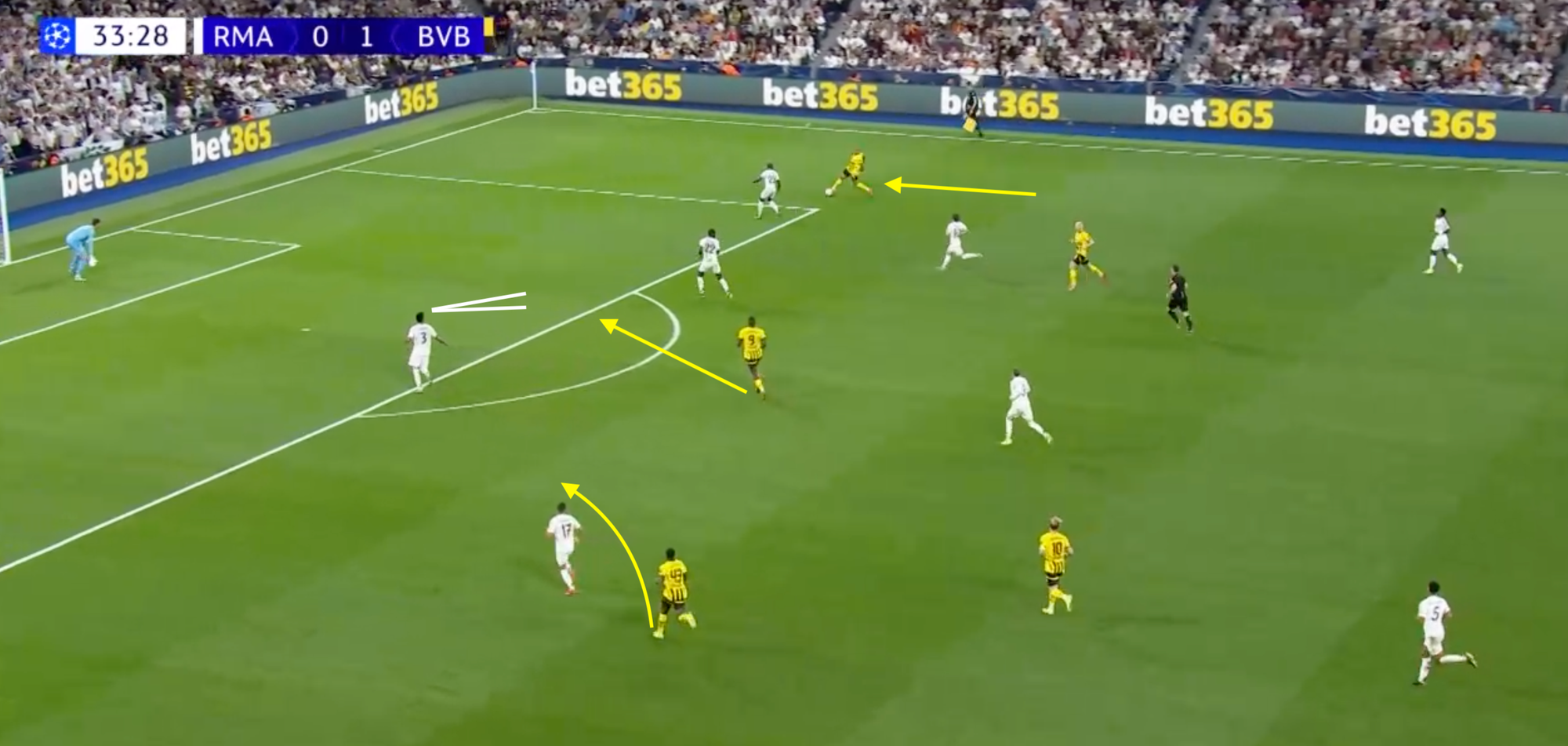
Instead, Guirassy held his run as Malen looked to cross, picking up a crucial position away from the six-yard box.
This, in turn, limited Militão’s ability to fully commit to a deeper defensive position where he could cut out the inevitable low cross.
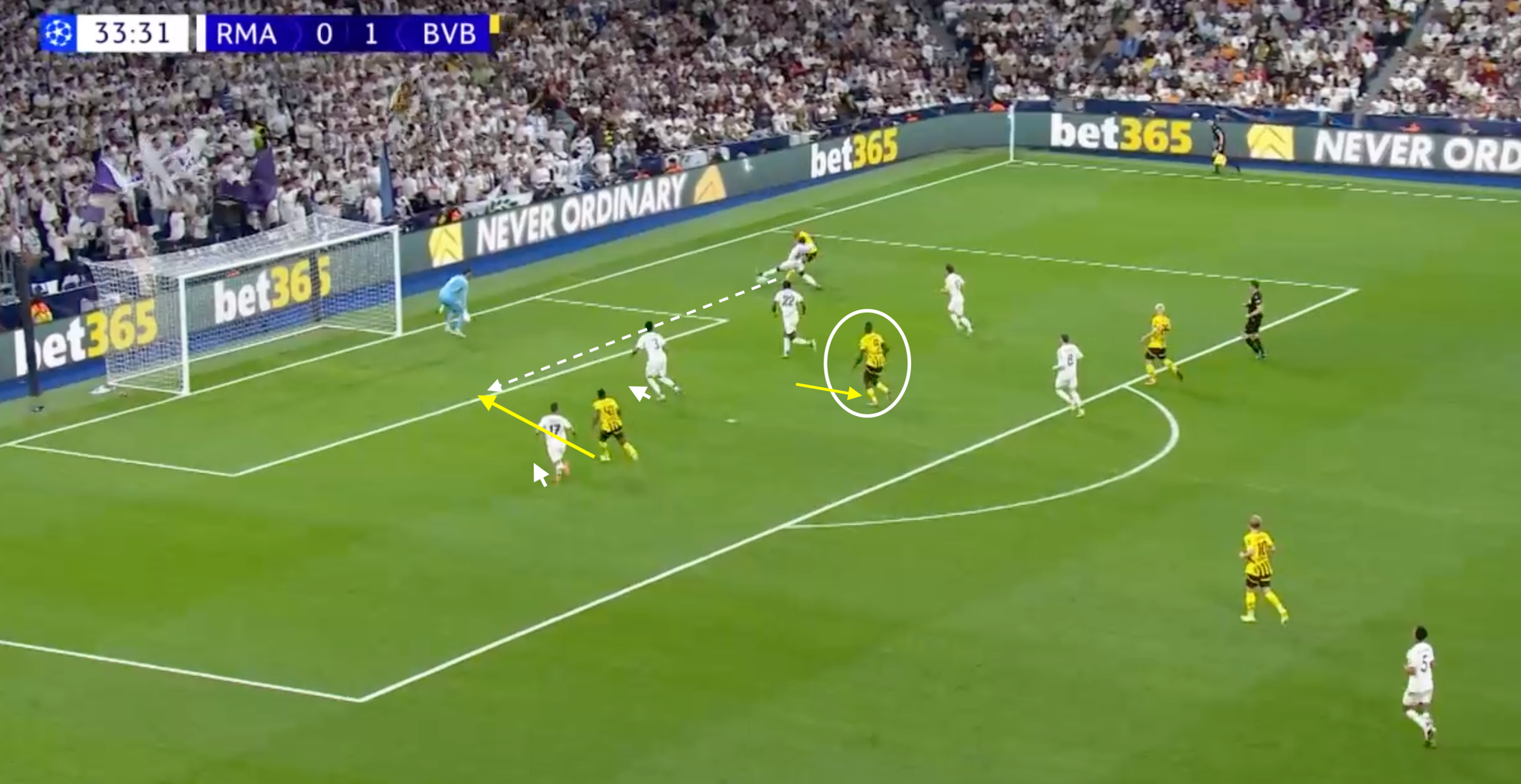
Coupled with Vázquez appearing to switch off when defending the back post, Gittens was allowed to slide in and convert, giving the German side a crucial two-goal advantage heading into halftime.
Dortmund held large spells of possession thanks to their impressive ball circulation and ability to manipulate the opposition press.
Madrid’s disjointed performance when out of possession contributed to Nmecha’s comfortable first half at the base of midfield.
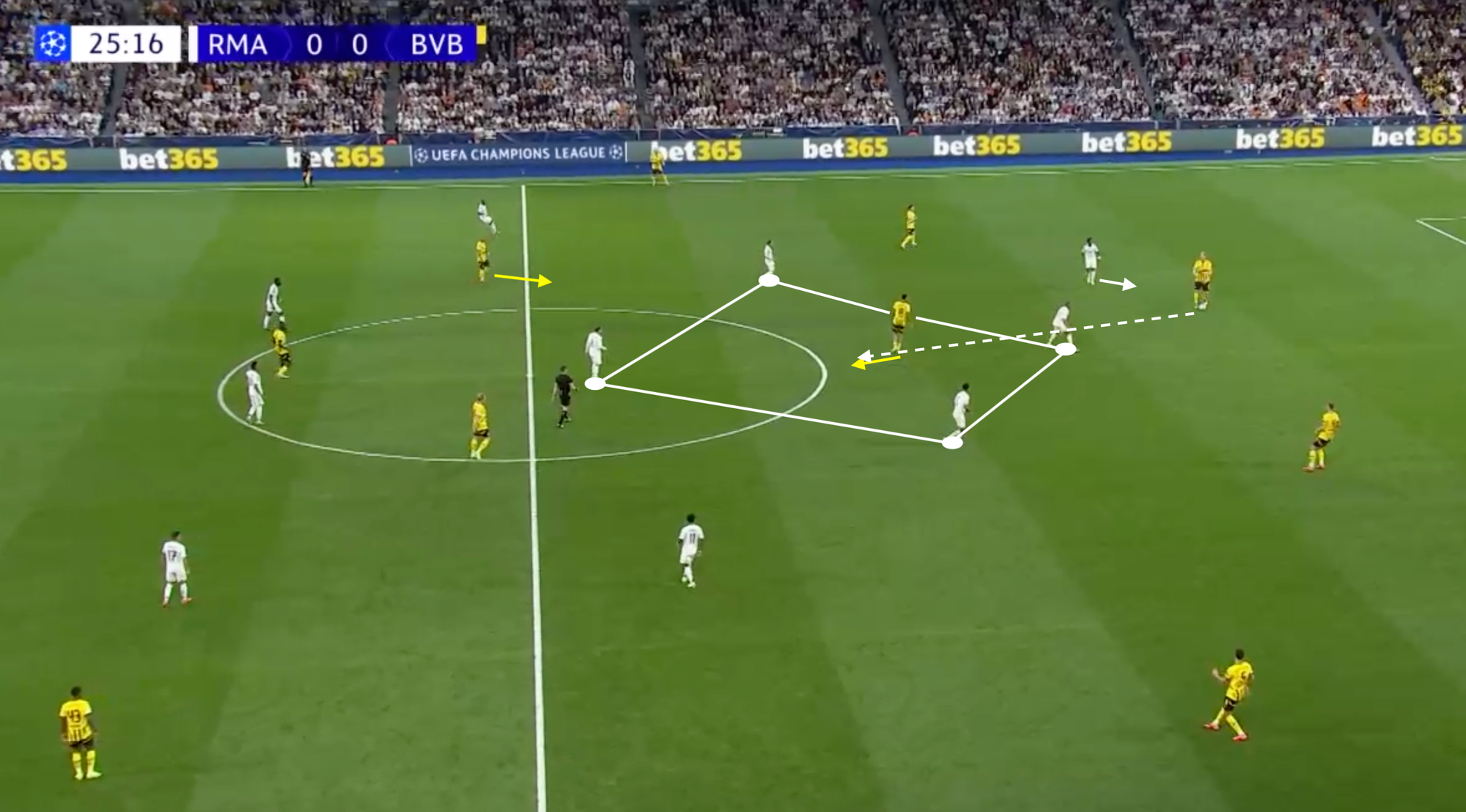
Real Madrid’s Attacking Fortunes
In the first half, we saw Real Madrid’s attacking efforts continually threaten the Dortmund goal, but importantly, they were unable to make the crucial breakthrough, whether it was through misfortune or a lack of cohesion.
Once again, the majority of Madrid’s attacking play was concentrated within the left half-space as a result of Mbappé’s movement towards Vinicius Jr., but this left the home side without a true striking presence within the penalty area.
Real Madrid were able to progress the ball down either flank as a result of their direct long passing, but as the following example conveys, the French superstar was often caught waiting on the edge of the penalty area instead of breaking in towards the action areas.
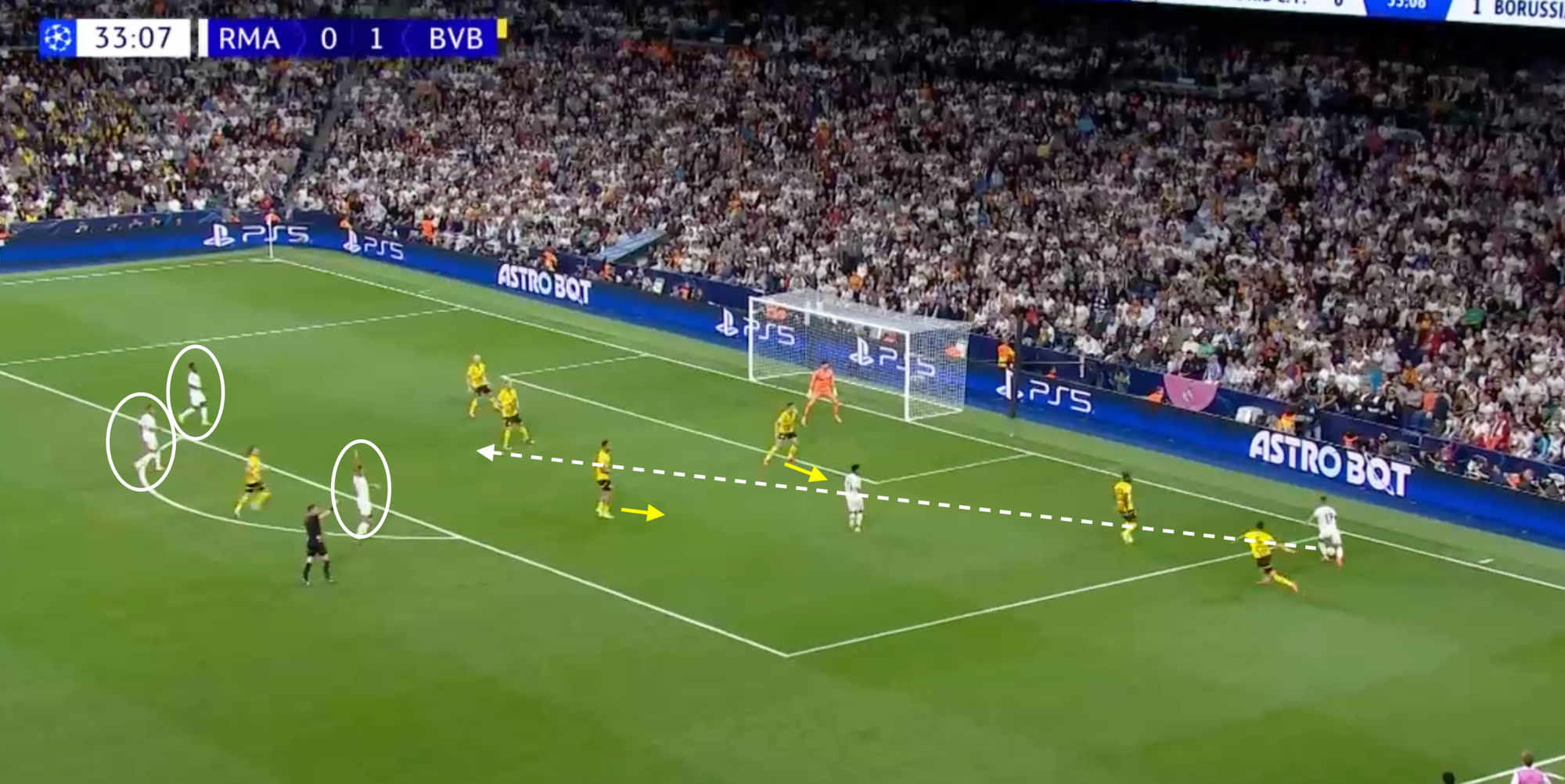
The halftime break saw an alteration in Carlo Ancelotti’s attacking structure.
We saw Mbappé operate within the right half-space to not only allow Vinicius Jr. to flourish on the left flank but also to stretch the Dortmund backline from all angles.
This coincided with an alteration early in the second half from Nuri Şahin’s tactics, where he opted for a more conservative approach with a five-man defensive line, sacrificing the electric attacking intent of Jamie Gittens for an extra central defender.
A move that should’ve, in theory, helped to bolster Dortmund’s defensive structure actually had an adverse effect on their ability to control the game, as it only fuelled Madrid’s fire and exposed them to wave after wave of energy-draining attacks.
The example below highlights how Mbappé’s explosive movement through the right half-space helped to create numerous goalscoring opportunities after the hour mark, timing his run to perfection to beat the deeper block of Borussia Dortmund.
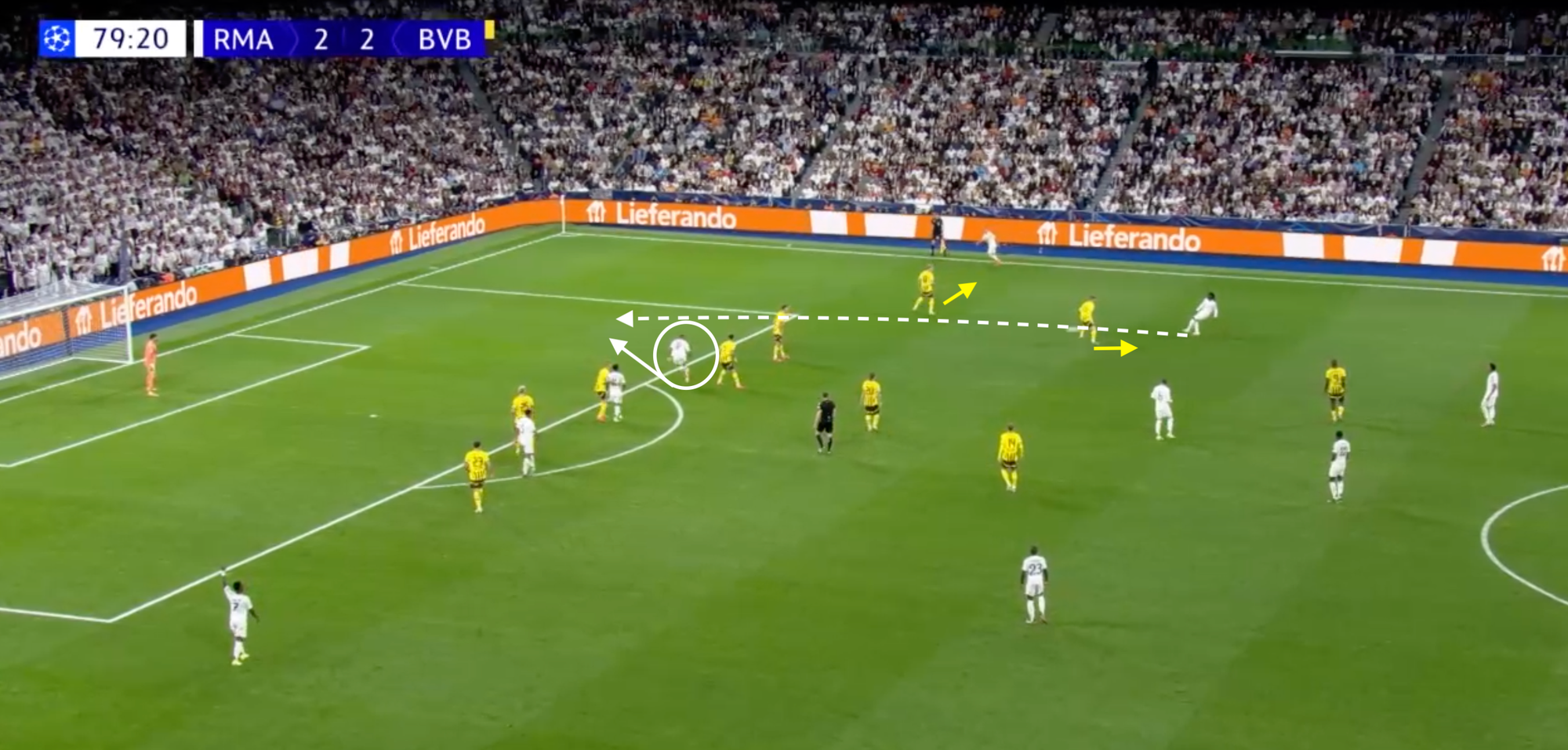
This coincided with the attacking movement of Lucas Vázquez, as the right-back was given the freedom to hold the width on the right flank in attacking scenarios, allowing Rodrygo to have much more privilege to roam around and combine with either flank- further enhancing the unpredictability and effectiveness of Madrid’s attack in the second half.
Patching Up Problems
When looking at Dortmund’s ability to beat the Real Madrid press in the second half, it would appear as though Şahin’s conservative switch limited their success when playing through the lines and having the necessary firepower to take advantage as they did in the opening half.
Real Madrid remained committed to a high-pressing structure in the second half, with Kobel shown here opting for the longer pass over the top of the Madrid midfield line in search of their target man, who had been so effective in linking play.
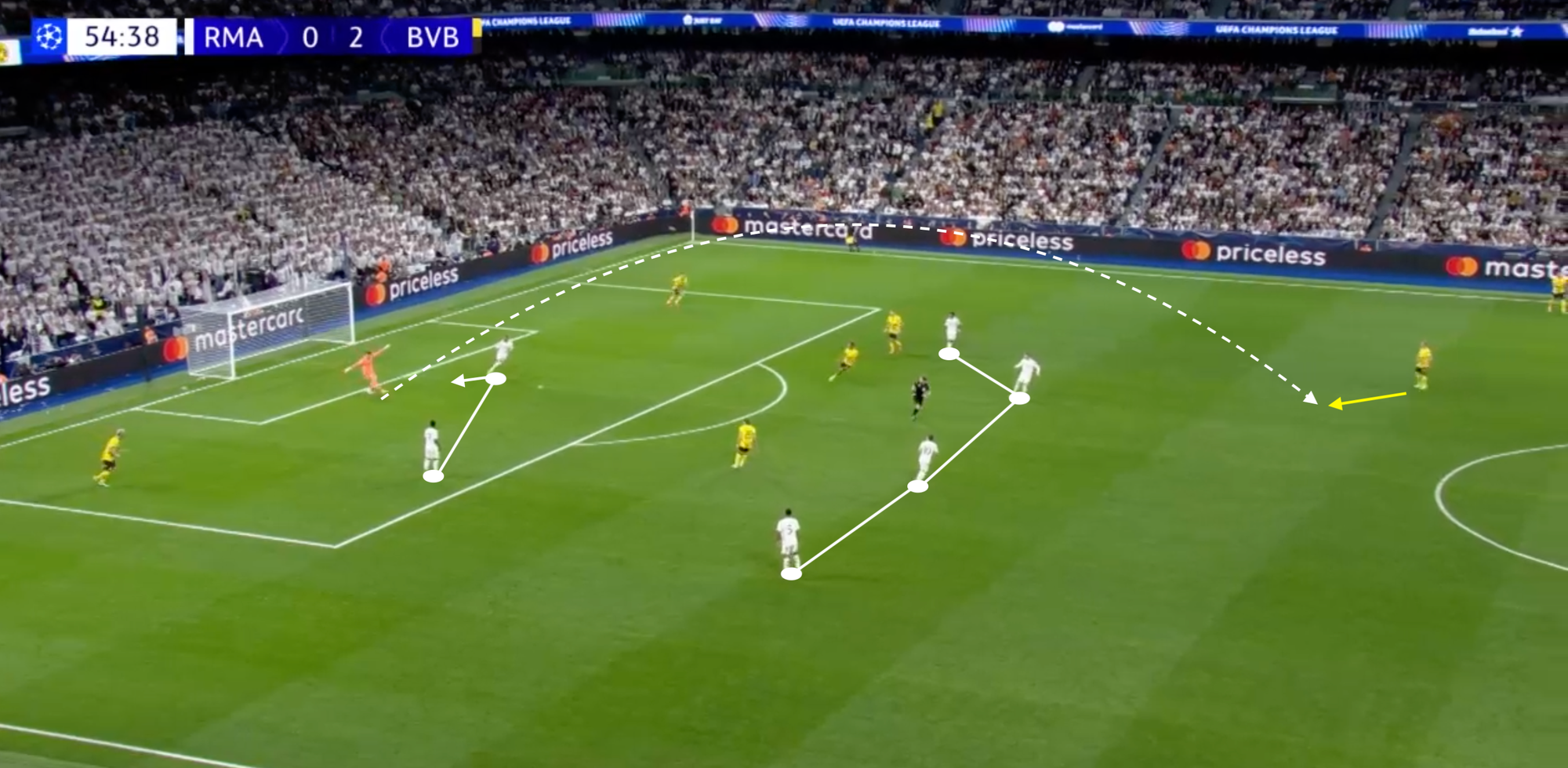
Dortmund’s problem was that once Guirassy or Brandt could take control of the ball in the middle third, they lacked the necessary spark to attack Madrid quickly in transition; perhaps they underestimated how useful Gittens’s speed was going forward.
It allowed Madrid to operate at a much greater depth, which in turn forced more opportunities to create turnovers and pinned Dortmund back within their own half.
Rodrygo’s effectiveness wasn’t limited to his work in possession.
The Brazilian’s defensive commitments were a huge reason why Madrid could mitigate Dortmund’s attacking threat, especially between the lines.
With the match level late in the second half, Rodrygo’s shift across to the left flank became an important piece of Madrid’s out-of-possession play.
His deeper left-back position shadowed Ryerson’s run but also provided great numerical superiority to support defensive actions.
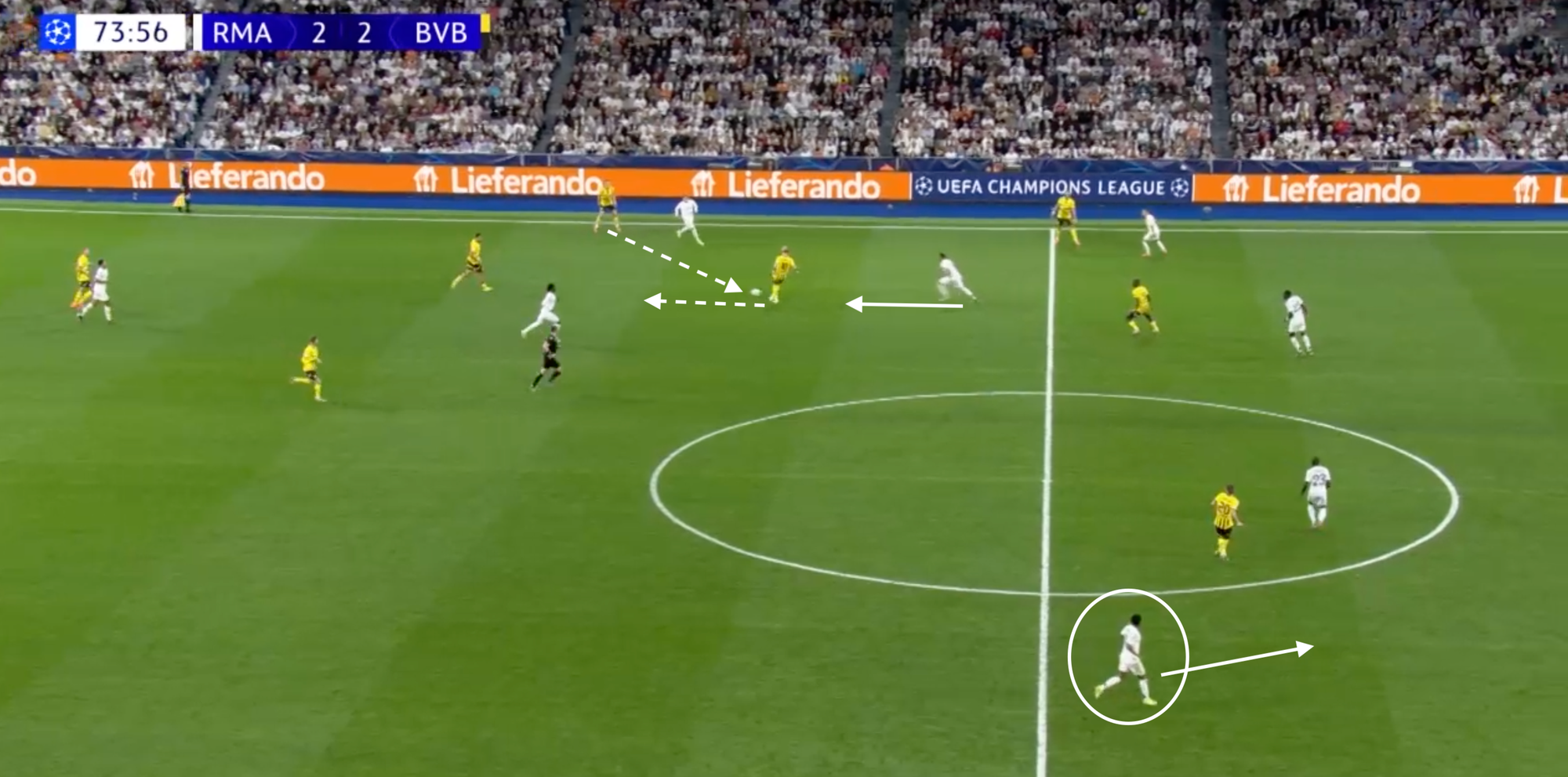
As a result, we see how an extra man within the defensive line could give Militão the confidence to remain proactive in his defensive style, engaging higher up the pitch to deny Brandt the space to turn and drive towards the final third when receiving between the lines.
Conclusion
Just when things appeared out of reach for Real Madrid, they found a way to get their most influential players in the positions that would best damage their opposition, something that has been critical to their successes this season.
This match was a massive lesson in the young managerial career of Nuri Şahin, who appeared to have everything under control before inviting too much pressure for his defensive line to handle, unleashing the Ballon d’Or winning talent of Vinicius Junior.
Both sides will use this match as a massive learning point as they continue into the league phase of the UEFA Champions League, with both Ancelotti and Şahin hoping that this performance will spark the necessary reaction heading into a huge weekend of matches in their respective domestic competitions.

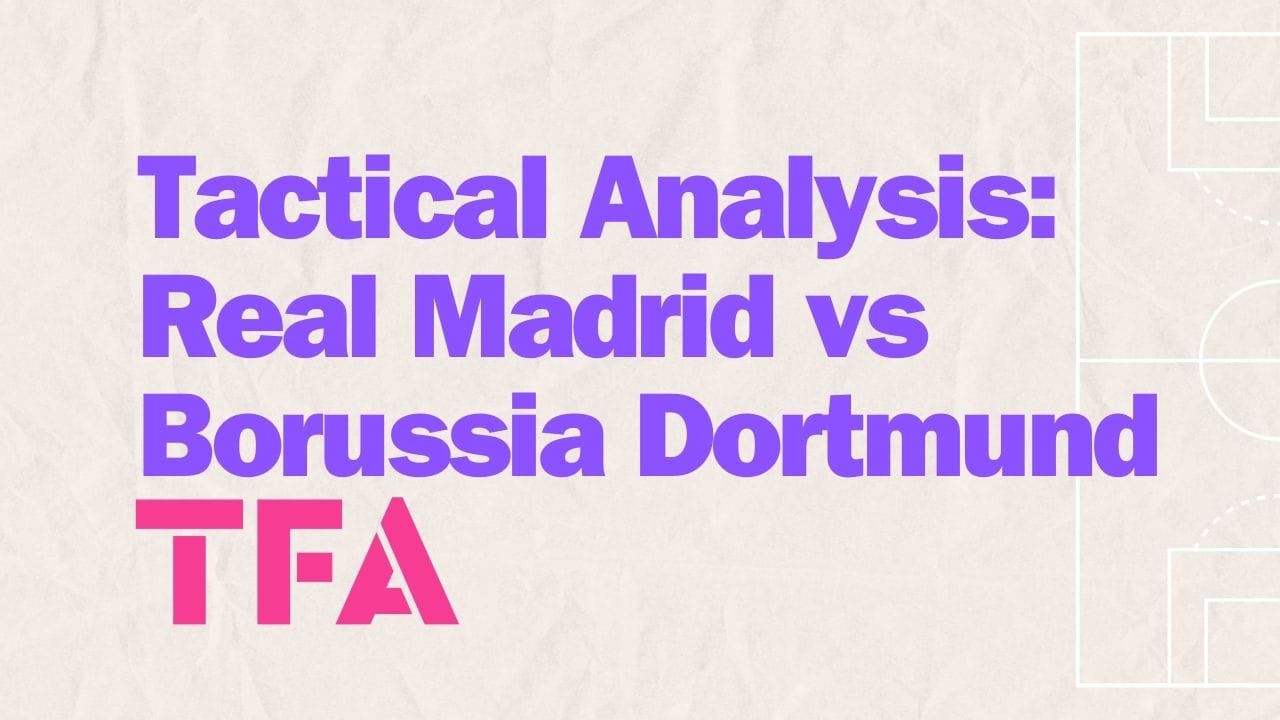



Comments